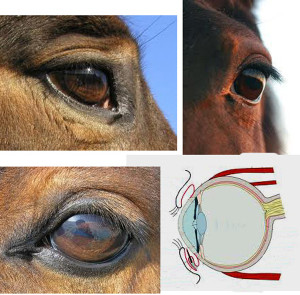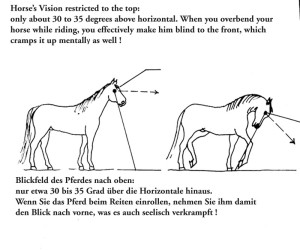Understand your Horse – Part 11
|
|
Ihr Pferd verstehen – Teil 11
|
Eyes 1
- In the last Blogs we looked at the “language” of the horse’s ears and found that there is a whole list:
- Attentive ears, including attentive relaxed, neutral ears, sleepy ears, helpless ears (horse at a loss), questioning ears, depressed ears or horse in pain, appeasing and submissive ears, annoyed ears, aggressively pinned ears and play ears.
- But we noted each time that other factors have to be taken into account, in order to be able to read the meaning of the ear posture correctly.
- The eyes play a large role in the interpretation of what a horse’s face is communicating in terms of his mood and feelings. But before we go into this, we should look at the horse’s eyes in more general terms – because horses perceive the world so differently from us! How can we understand our partners, if we don’t even know what they see?
|
|
Augen 1
- Im letzten Blog haben wir die „Sprache“ der Pferdeohren betrachtet und eine ganze Liste von Gefühlsäußerungen gefunden:
- Aufmerksame Ohren, inklusive relaxiert, neutrale und Schlafohren, ratlose und fragende Ohren, deprimierte Ohren (oder Pferd mit Schmerzen), beschwichtigende und unterwürfige Ohren, ärgerliche Ohren, aggressiv angepreßte und Spielohren.
- Aber jedesmal haben wir festgestellt, daß auch andere Faktoren miteinbezogen werden müssen, um die mit den Ohren ausgedrückte Verfassung richtig zu deuten.
- Die Augen spielen bei der Interpretation der Gemütsverfassung, die das Pferd mit dem Gesicht ausdrückt, eine große Rolle. Aber bevor wir das betrachten, müssen wir kurz die Augen des Pferdes generell verstehen – sie sehen die Welt ja so anders als wir unsere! Wie könnten wir unsere Partner verstehen, wenn wir nicht mal wissen, was sie sehen?
|
|
|
The main difference between our outlooks on the world:
- You know by now that the horse is a flight animal, whereas humans are predators. Over the evolution time of the species nature has adapted each of them in such a way that it has the best chances to survive. This must of course include the way to SEE.
- Predators must be able to see in such a way that they can stalk and catch prey successfully – otherwise starvation and death. Therefore predators have the eyes on the front of their faces and they have focused vision and depth perception, because the brain puts the two pictures (from the right and the left eye) together and produces in the brain ONE picture. You see exactly what you stalk – and you know exactly where to pounce!
- Flight animals however must be able to avoid being stalked too closely and eaten – obviously! So they have to scan the horizon in such a way that they recognize the approach of any predator early enough to start flight when still at a safe distance. It is much better to run once too often (and perhaps exert energy unnecessarily) than one time too few – you become the meal!! For this it is not so important to see a focused picture – the main thing is to recognize motion, ANY motion, even the most careful slinking of the cat in the grass.
Retina with Rods and cones:
- Horses have rods and cones on the retina of their eyes, just like we do, but they have more rods, which are bundled close together on the retina and thus permit them to see motion much faster than we do –this also enables them to see better in low light conditions (horses in the wild are nocturnal animals too). The cones make it possible to distinguish colour, and of those horses have only two kinds (humans three and bird four – more about colour later).
Field of vision:
- To scan the horizon in an effective way flight animals have their eyes on the side of their heads and a field of vision of almost 360 degrees (approx. twice that of humans). Their pupils are not round, but oval and horizontal, giving them a panoramic vision.
|
|
Der Hauptunterschied unserer „Welt-Anschauungen“:
- Sie wissen ja jetzt, daß das Pferd ein Fluchttier ist, wir Menschen aber Raubtiere. Über die Entwicklungszeit der Arten hat die Natur jede Spezie in so einer Weise adaptiert, daß sie die besten Überlebenschancen hat. Das schließt natürlich auch die Art des SEHENS ein.
- Raubtiere müssen so sehen, daß sie sich gezielt anpirschen und ihre Beute erwischen können – sonst Tod durch Verhungern. Daher haben Raubtiere ihre Augen vorn im Gesicht, und sie haben ein dreidimensionales scharfes Bild, da das Gehirn die beiden Bilder (vom rechten und linken Auge) zusammenlegt und im Gehirn EIN Bild produziert. So sieht man genau, an was man sich anschleicht – und weiß genau, wann man zuschlagen kann!
- Fluchttiere dagegen müssen es zu vermeiden wissen, daß man sich zu nahe an sie anpirscht – und dann gefressen wird – klar! Sie müssen also den Horizont so absuchen können, daß sie die Annäherung jedweden Raubtiers früh genug erkennen können, um zu flüchten, solange man noch in sicherem Abstand ist. Es ist besser, einmal zu oft loszurennen (und vielleicht unnötige Energie dabei zu verschwenden), als einmal zu wenig – sonst wird man zum Steak! Es ist also nicht so wichtig ein scharfes Bild zu sehen, sondern Bewegung, JEDE Bewegung, sogar das verstohlendste Schleichen der Katze im Gras.
Retina mit Stäbchen und Zäpfchen:
- Pferde haben Stäbchen und Zäpfchen auf der Netzhaut ihrer Augen wie wir, aber sie haben mehr Stäbchen, die auf der Retina eng gebündelt liegen, und können daher Bewegung schneller sehen als wir – auch sehen sie damit besser in Zwielichtverhältnissen und im Dunkeln (Pferde in freier Wildbahn sind ja auch Nachttiere). Die Zäpfchen sind zum Farbsehen da, und davon haben Pferde nur zwei Arten (wir haben drei und Vögel vier – mehr über Farben später).
Gesichtsfeld:
- Um ständig den Horizont effektiv absuchen zu können, haben Fluchttiere die Augen seitlich am Kopf und damit ein Gesichtsfeld von fast 360 Grad (etwa doppelt soviel wie beim Menschen). Ihre Pupillen sind nicht rund, sondern horizontal und länglich –das ermöglicht ihnen ein Panorama- Rundumsehen.
|
|
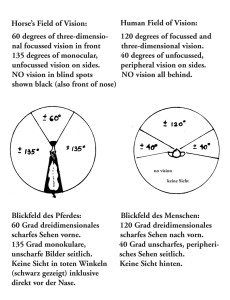
|
- The picture shows where in this range the vision is focused – only in the field of both eyes is the picture relatively clear and three-dimensional. Therefore horses want to turn their head in the direction of perceived trouble to get a better view. The perception of depth (binocular vision) takes up only about 15 to 20 degrees of the 360. Only directly in front of his nose and also directly behind his tail the horse sees nothing – these are the blind spots, which the horse is trying to cover by frequently turning his head and by walking on zigzagging paths (if you allow him to!)
- The horse’s extravagantly big eyeball magnifies everything 50% larger than we perceive it. Distant objects are thus seen in clearer detail. But the horse’s vision is monocular in almost all of the range, (i.e. except the previously mentioned 15 to 20 degrees) – on the sides each eye sees a different picture! Some sources say that these pictures get superimposed in the horse’s brain, but more serious research stresses that their vision is not “stereo”, but rather that their brain processes the two pictures independently as Right Vision and Left Vision, and those pictures are two-dimensional. The horse’s Corpus Callosum, which is the connection between the right and left half of the brain, is developed to a much lesser degree in the horse than in humans. This means that the interchange of information between the two halves functions to a lesser degree.
The “spooky side”:
- Scientists now say that this is a myth:
- It was previously assumed that when you pass a “spooky” object on the way to some place (and you are knowledgeable and therefore guide its exploration the way you have learned in previous Blogs) – this object is again JUST AS spooky on the way back? “You goof!” you say “we inspected that half an hour ago!” Aha! Yes, we did, but that was the left side of the brain and the information did not register on the other side (now he sees it with the left eye, which registers in the right side of the brain!) After multiple experiments [google also Evelyn B. Hanggi’s reseach papers for more information] this now seems to be untrue – inter-ocular transfer of information DOES take place.
- For a long time we all learned that the right side of the brain is the “emotional” side, which would explain that horses tend to spook more from things perceived with the left eye. I have not been able to confirm that with my horses and newer brain research also refutes such statements.
Field of vision to the top:
- Since horses don’t have natural enemies attacking them from the skies, their vision angle to the top is limited, unless they lift and turn their entire head. Much more important is to assess things moving on the ground – where predators mainly come from.
|
|
- Das Bild zeigt in welchem Bereich das Pferd scharf sehen kann – nur in dem Feld, wo beide Augen dasselbe sehen, ist das Bild scharf und drei-dimensional. Daher wollen Pferde auch immer ihren Kopf in die Richtung drehen, aus der sie Schwierigkeiten erwarten, um etwas genau sehen zu können. Diese Tiefenschärfe ist aber nur in etwa 15 bis 20 Grad vorhanden. Nur direkt vor seiner Nase und ebenfalls direkt hinter seinem Schweif sieht das Pferd nichts – das sind die toten Winkel, die es immer abzudecken sucht, indem es seinen Kopf dreht und auch auf Zickzackpfaden läuft (wenn Sie ihm das erlauben).
- Der außerordentlich große Augapfel des Pferdes vergrößert alles um 50% mehr als wir es sehen. Entfernte Objekte werden so klarer erkannt. Aber das Sehen des Pferdes ist monokular in fast dem ganzen Bereich (außer eben in den schon erwähnten 15 bis 20 Grad vorne) – auf den Seiten aber sieht es zwei verschiedene Bilder! Manche Quellen behaupten, daß diese Bilder im Gehirn übereinander gelegt werden, aber seriösere Wissenschaftler sagen, daß das Sehen nicht „stereo“ ist, sondern daß das Gehirn unabhängig voneinander zwei Bilder als RechtsSehen und LinksSehen verarbeitet. Diese Bilder sind zwei-dimensional. Das Corpus Callosum des Pferdes, welches die Verbindung zwischen der rechten und linken Gehirnhälfte darstellt, ist aber weit weniger als im Menschen entwickelt. Damit hapert es mit dem Austausch der Informationen etwas.
Die „Scheu“ seite:
- Wissenschaftler sagen nun, das sei ein Mythos:
- Es wurde immer angenommen, daß, wenn Sie etwas Beunruhigendes am Wege antreffen (und mit Ihrem Wissen das Erforschen fachmännisch anleiten, wie Sie das in früheren Blogs gelernt haben) – dieses Objekt auf dem Rückweg nochmal GENAUSO beunruhigend ist? „Dummerchen!“, sagen Sie „das haben wir doch vor einer halben Stunde schon genau beguckt!“ Aha! Ja, aber das war die linke Seite des Gehirns und die Information hat sich rechts nicht niedergeschlagen (jetzt sieht es was mit dem linken Auge, was im rechten Gehirnteil verarbeitet wird!) Nach vielfachen Experimenten [googlen Sie auch Evelyn B. Hanggis Artikel für weitere Information] scheint das nun nicht der Fall zu sein – inter-okularer Austausch von Informationen findet statt!
- Lange Zeit haben wir alle gehört, daß die rechte Gehirnhälfte die „emotionale“ sein soll, was erklären würde, daß viele Pferde eher vor Dingen scheuen, die sie mit dem linken Auge sehen. Ich kann das bei meinem Pferden nicht bestätigen und neuere Gehirnforschung scheint das nun auch zu widerlegen.
Blickfeld nach oben:
- Da Pferde aus den Lüften keine natürlichen Feinde haben, ist ihr Gesichtsfeld nach oben begrenzt, außer wenn sie den ganzen Kopf heben und drehen. Viel wichtiger ist ihnen das Taxieren des Bodens, denn Raubtiere kommen von unten.
|
|
|
- The more astonishing it is that horses allow us to sit on their backs – apart from being in a position, where naturally only a predator (ready to eat him!) would be, they can’t even see us there! If on top of that you rode your horse with his head behind the vertical, (a position, which unfortunately we still see too often) you therefore would not only give great discomfort to your horse (cramped neck musculature etc.), but also effectively make him blind to the front, which adds psychological discomfort to the physical one.
Colour vision:
- Humans have three types of cones on the retina, which is called trichromic vision, and see four basic unique colours: red, green, blue, and yellow, as well as a range of intermediate hues. Horses have only two types of cones (dichromatic vision) and cannot distinguish red.
|
|
- Um so erstaunlicher ist es, daß sie uns erlauben, den Platz auf ihrem Rücken einzunehmen – denn abgesehen davon, daß dies der Fleck ist, wo sich das Raubtier (welches es grade fressen will) befände, können sie uns dort auch gar nicht sehen! Wenn Sie dazu noch Ihr Pferd mit der Nase hinter der Vertikalen ritten (in einer Haltung, die man leider noch viel zu oft sieht), würden Sie Ihrem Pferd nicht nur körperliche Beschwerden (wie verkrampfte Halsmuskulatur) zufügen, sondern ihm auch noch nach vorne tatsächlich die Sicht nehmen, was den körperlichen Schmerz noch mit seelischem Unbehagen verschlimmert.
Farbsehen:
- Menschen haben drei Arten von Zäpfchen auf der Retina, (trichromic vision), womit man vier Basisfarben Rot, Grün, Blau und Gelb, sowie Übergangsfarben dazwischen unterscheiden kann. Pferde haben nur zwei Arten von Zäpfchen (dichromatic vision) und können Rot nicht unterscheiden.
|
|
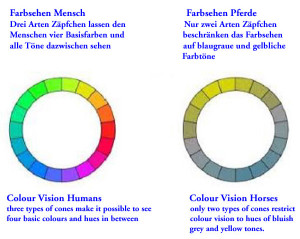
|
- This may be less important for our communication with the horse, but very interesting nevertheless. If the grass and the dandy lions really look so similar in his eyes, as I deduct from the offered diagram of colours, why then do my horses aim for them so purposefully? If the carrot is so grey on grey grassy ground, how come they find it so promptly on finger signs? Do they rather recognize it by shape or smell?
- It is very interesting to immerse yourself in your horse’s world and try to experience it through his eyes and other senses!
- If I had to manage four feet AND see two different pictures at the same time, mostly in bluish-yellowish tinges, I think I would be so confused that I wouldn’t be able to walk any more at all! And yet, horses have lived far longer than our species, so the system must be very effective!
|
|
- Für unsere Kommunikation mit dem Pferd ist das zwar weniger wichtig, aber dennoch interessant –wenn das Gras und der Löwenzahn in seinen Augen wirklich so ähnlich aussehen wie ich das der Farbskala entnehme, wieso streben meine Pferde dennoch so gezielt darauf zu? Wenn die Möhre so grau auf grasgrauem Boden ist, wieso finden sie das Stückchen so leicht auf Fingerzeig? Erkennen sie sie eher an der Form, am Geruch?
- Es ist sehr interessant sich in sein Pferd hineinzudenken und zu versuchen, die Welt durch seine Augen und andere Sinne zu verstehen!
- Wenn ich vier Füsse sortieren UND gleichzeitig auf jeder Seite ein anderes Bild sehen müßte, das meiste davon auch noch in nur bläulich-gräulichen Tönen, dann wäre ich sicher so verwirrt, daß ich gar nicht mehr laufen könnte! Und doch haben Pferde ja so viel länger als unsere Spezie überlebt und das System muß erstaunlich effektiv sein!
|
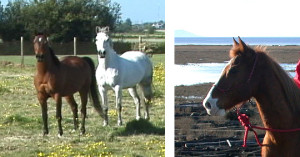 When the eyes are looking at something in the focussed range, the ears are always pointed to the front !
Wenn die Augen im fokussierten Bereich etwas ansehen, sind die Ohren immer nach vorn gespitzt ! |
This is the world your horse sees! Next time we go into what the horse communicates to us with his eyes!
Read on !!
|
|
So also sieht Ihr Pferd! Nächstes Mal schauen wir, was es uns mit den Augen sagen kann.
Lesen Sie weiter !!
|

